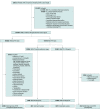Analysis of Time to Diagnosis and Outcomes Among Adults With Primary Hyperparathyroidism
- PMID: 36574247
- PMCID: PMC9857508
- DOI: 10.1001/jamanetworkopen.2022.48332
Analysis of Time to Diagnosis and Outcomes Among Adults With Primary Hyperparathyroidism
Abstract
Importance: Despite access to routine laboratory evaluation, primary hyperparathyroidism (PHP) remains underdiagnosed and undertreated.
Objective: To determine the consequences associated with missed diagnoses and prolonged time to diagnosis and treatment of PHP.
Design, setting, and participants: This is a retrospective cohort study of patients older than 40 years with 2 instances of hypercalcemia during 2010 to 2020 and 3 years of follow-up. Patients were recruited from 63 health care organizations in the TriNetX Research Network. Data analysis was performed from January 2010 to September 2020.
Exposures: Elevated serum calcium.
Main outcomes and measures: Existing symptoms and diagnoses associated with PHP (osteoporosis, fractures, urolithiasis, major depressive disorder, anxiety, hypertension, gastroesophageal reflux disease, malaise or fatigue, joint pain or myalgias, constipation, insomnia, polyuria, weakness, abdominal pain, headache, nausea, amnesia, and gallstones) compared in patients deemed high-risk and without a diagnosis and matched controls, and those who experienced times from documented hypercalcemia to diagnosis and diagnosis to treatment within or beyond 1 year.
Results: There were 135 034 patients analyzed (96 554 women [72%]; 28 892 Black patients [21%] and 88 010 White patients [65%]; 3608 Hispanic patients [3%] and 98 279 non-Hispanic patients [73%]; mean [SD] age, 63 [10] years). Two groups without a documented diagnosis of PHP were identified as high risk: 20 176 patients (14.9%) with parathyroid hormone greater than or equal to 50 pg/mL and 24 905 patients (18.4%) with no parathyroid hormone level obtained or recorded explanation for hypercalcemia. High-risk patients experienced significantly increased rates of all associated symptoms and diagnoses compared with matched controls. Just 9.7% of those with hypercalcemia (13 136 patients) had a diagnosis of PHP. Compared with individuals who received a diagnosis within 1 year of hypercalcemia, those whose workup exceeded 1 year had significantly increased rates of major depressive disorder, anxiety, hypertension, gastroesophageal reflux disease, malaise or fatigue, joint pain or myalgias, polyuria, weakness, abdominal pain, and headache at 3 years. The rate of osteoporosis increased from 17.1% (628 patients) to 25.4% (935 patients) over the study period in the group with delayed diagnosis. Among those with a diagnosis, 5280 patients (40.2%) underwent parathyroidectomy. Surgery beyond 1 year of diagnosis was associated with significantly increased rates of osteoporosis and hypertension at 3 years after diagnosis compared with those treated within 1 year.
Conclusions and relevance: Many patients were at high risk for PHP without a documented diagnosis. Complications in these patients, as well as those who received a diagnosis after prolonged workup or time to treatment, resulted in patient harm. System-level interventions are necessary to ensure proper diagnosis and prompt treatment of PHP.
Conflict of interest statement
Figures

Similar articles
-
Early biochemical response to parathyroidectomy for primary hyperparathyroidism and its predictive value for recurrent hypercalcemia and recurrent primary hyperparathyroidism.Surgery. 2021 Jan;169(1):120-125. doi: 10.1016/j.surg.2020.05.049. Epub 2020 Aug 5. Surgery. 2021. PMID: 32768241
-
The phenotype of primary hyperparathyroidism with normal parathyroid hormone levels: how low can parathyroid hormone go?Surgery. 2011 Dec;150(6):1102-12. doi: 10.1016/j.surg.2011.09.011. Surgery. 2011. PMID: 22136828
-
Evaluation for Primary Hyperparathyroidism in Patients Who Present With Nephrolithiasis.J Surg Res. 2021 Jan;257:79-84. doi: 10.1016/j.jss.2020.07.049. Epub 2020 Aug 17. J Surg Res. 2021. PMID: 32818787
-
Calcium homeostasis and hyperparathyroidism: Nephrologic and endocrinologic points of view.Ann Endocrinol (Paris). 2022 Aug;83(4):237-243. doi: 10.1016/j.ando.2022.05.003. Epub 2022 May 19. Ann Endocrinol (Paris). 2022. PMID: 35598638 Review.
-
Primary hyperparathyroidism.Best Pract Res Clin Endocrinol Metab. 2018 Oct;32(5):593-607. doi: 10.1016/j.beem.2018.09.004. Epub 2018 Sep 22. Best Pract Res Clin Endocrinol Metab. 2018. PMID: 30449543 Review.
Cited by
-
The Landmark Series: Management of Primary Hyperparathyroidism.Ann Surg Oncol. 2025 May;32(5):3126-3134. doi: 10.1245/s10434-025-17045-x. Epub 2025 Mar 1. Ann Surg Oncol. 2025. PMID: 40025363 Review.
-
Opportunities to improve the diagnosis and treatment of primary hyperparathyroidism: retrospective cohort study.Gland Surg. 2024 Jul 30;13(7):1201-1213. doi: 10.21037/gs-24-128. Epub 2024 Jul 24. Gland Surg. 2024. PMID: 39175695 Free PMC article.
-
Impact of intraoperative intact PTH monitoring on reoperation rates and surgical success in primary hyperparathyroidism.BMC Endocr Disord. 2025 Apr 25;25(1):116. doi: 10.1186/s12902-025-01942-z. BMC Endocr Disord. 2025. PMID: 40281464 Free PMC article.
-
An Analysis of Primary Hyperparathyroidism in Association with Depression or Anxiety.Diseases. 2025 Feb 12;13(2):54. doi: 10.3390/diseases13020054. Diseases. 2025. PMID: 39997061 Free PMC article. Review.
-
PTH levels, sleep quality, and cognitive function in primary hyperparathyroidism.Endocrine. 2023 Aug;81(2):379-387. doi: 10.1007/s12020-023-03410-x. Epub 2023 Jun 2. Endocrine. 2023. PMID: 37266901
References
-
- Gopinath P, Mihai R. Hyperparathyroidism. Surgery. 2011;29(9):451-458. doi:10.1016/j.mpsur.2011.06.015 - DOI
Publication types
MeSH terms
Substances
Grants and funding
LinkOut - more resources
Full Text Sources
Medical

